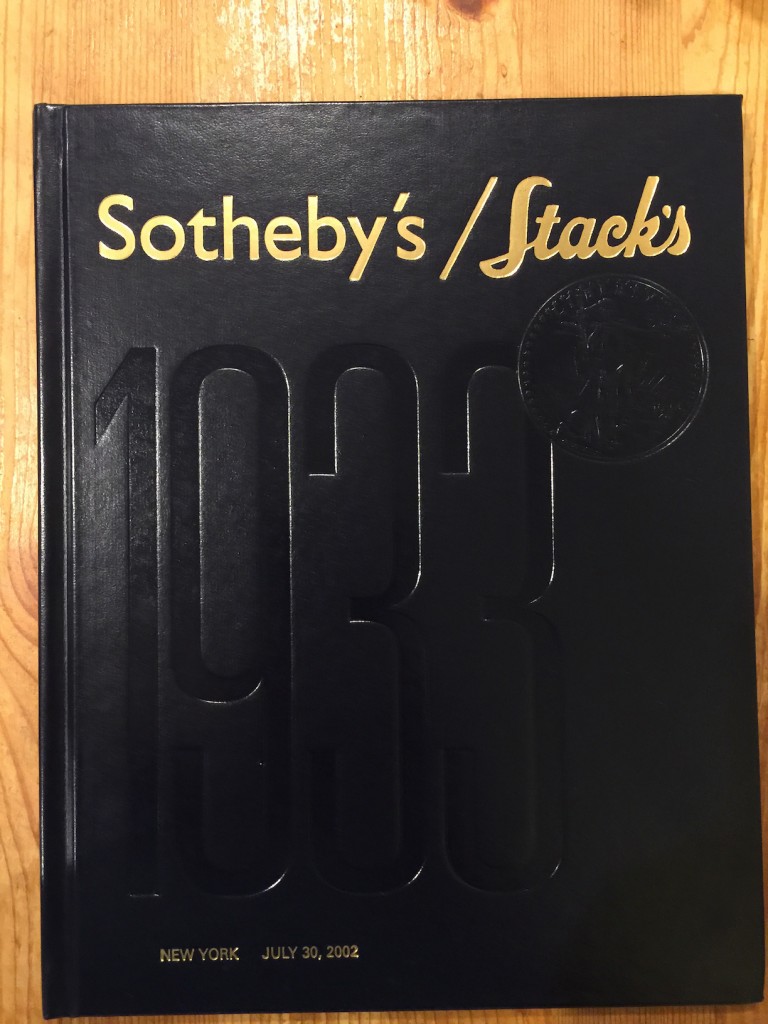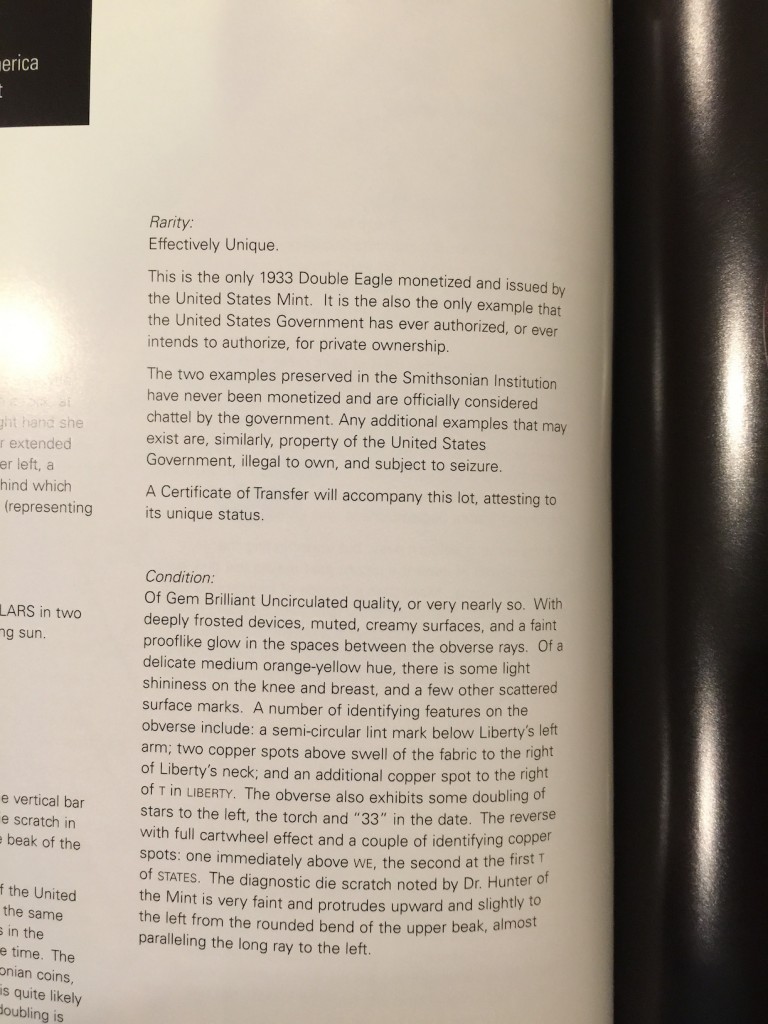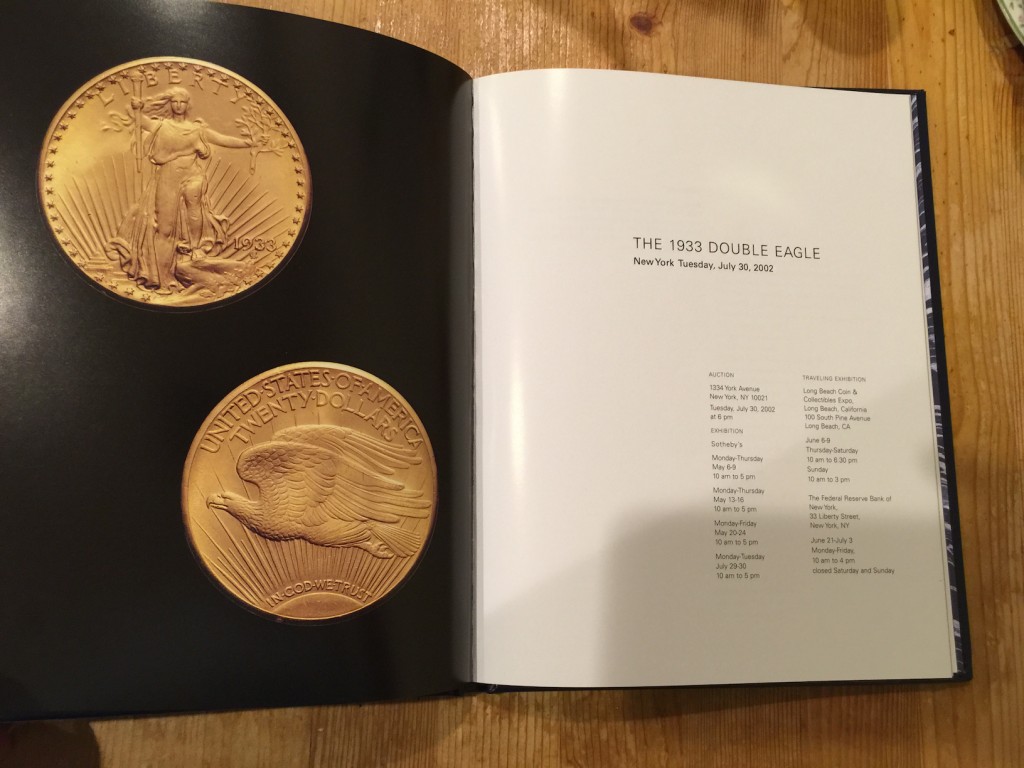Nov 26, 2015 | celebration, coins, history
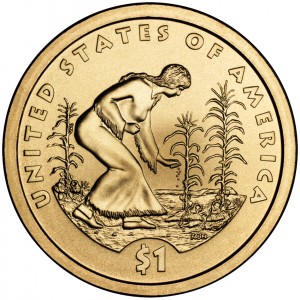
2009 Native American Dollar — Spread of Three Sisters
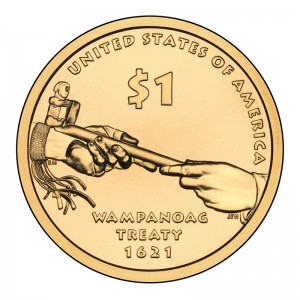
2011 Native American Dollar — Supreme Sachem Ousamequin, Massasoit of the Great Wampanoag Nation Creates Alliance with Settlers at Plymouth Bay (1621)
Thanksgiving was first celebrated in 1621 by the Dutch settlers at Plymouth, Massachusetts to celebrate a successful harvest. It was a tradition that the Pilgrims brought with them from Europe. The three-day event was attended by 53 Pilgrims and 90 Native Americans that lasted three days. The tradition of giving thanks for successes was a tradition that the Pilgrims brought with them from England. This three-day celebration in 1621 is considered the first Thanksgiving.
After the birth of the United States, President George Washington issued a proclamation honoring the Thanksgiving harvest during his presidency. The only other president to issue a Thanksgiving proclamation was President James Madison. From then, it was up to the individual states to declare a Thanksgiving holiday.
Writer and editor Sarah Josepha Hale found a diary from the time of the Pilgrims and was moved to write editorials to bring back the Thanksgiving celebration. As part of her efforts, Hale developed recipes for roasted turkey, pumpkin pie, and stuffing that are part of the inspiration for today’s Thanksgiving feast. President Abraham Lincoln was so moved by Hale’s efforts that he decided that it was a good idea to maintain the union he issued a proclamation that made Thanksgiving Day a national holiday in 1863.
After Lincoln’s proclamation, it was traditional to celebrate Thanksgiving on the last Thursday of November. In a move to increase the holiday shopping period to promote more spending, President Franklin D. Roosevelt pushed to have congress pass a law to move Thanksgiving earlier in the month. In December 1941, Roosevelt signed a bill that set Thanksgiving as the fourth Thursday in November.
Be thankful for your life.
Be thankful for your family.
Be thankful for our hobby.
Be thankful for us all.
Happy Thanksgiving!
Coin images courtesy of the U.S. Mint.
Sep 24, 2015 | coins, foreign, history, US Mint
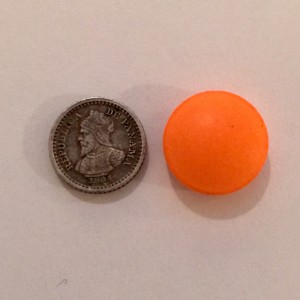
1902 Panama 2½ Centesimos on the left. On the right is a national brand coated aspirin.
Johnny: Making a Mint for $200
Alex: It’s the smallest coin struck by the U.S. Mint.
BEEP!
Johnny: What is the dime?
Alex: No, I’m sorry.
BEEP!
Alice: What is the penny?
Alex: Sorry, that’s not it either. Pat, do you want to guess?
BEEP!
Pat: What is the gold dollar coin?
Alex: No. The correct answer is “What is the 1904 Panama 2½ Centesimos coin?”
Weighing in at 1.25 grams, containing .900 silver (1.125 grams of silver), and measuring 10 millimeters in diameter, the coin nicknamed the Panama Pill is smaller than the silver three-cent piece, which was 14 millimeters in diameter, and the small gold dollar (Type 1) that was produced from 1849 through 1886. The gold dollar weighed 1.67 grams and was 15 millimeters in diameter.
Although there are smaller coins, such as the 9.09 millimeter Maximillian coin struck by the Mexico City Mint, this is the smallest ever produced by the U.S. Mint.
After Panama gained its independence in 1904, the new government made the decision to convert its monetary systems from the Columbian peso the balboa. Named in honor of the Spanish explorer Vasco Nunez de Balboa, the balboa would be subdivided into 100 centesimos to use for commerce. But Panama faced a similar problem that the United States faced over 100 years earlier. Since commerce was based on the Spanish Milled Dollar, which was 8 Reales, it was common for the coinage to be divided by 8 rather than 10. Simply, if something cost 1 Reale, referred to as 1 bit for when the milled dollar was physically cut for smaller denominations, a direct conversion would mean that an equivalent to the bit would be 12½ centesimos.
The United States solved this problem by striking the half-cent coin. Panama opted to strike a 2½ centesimos coin that would be paired with the 5, 10, 25, and 50 centesimos coins, all produced by the U.S. Mint. Rather than continually produce these coins until the bureaucracy caught up with commerce as was the case in the United States, Panama ordered 400,000 of these coins. The Panamanian people adapted to the new currency system, making this a one-year type coin.
During our monthly coin club meeting some members bring coins and boxes of foreign coins for other members to pick though. I went to the table where a member brought a box of loose foreign coins and someone found the Panama Pill in the box. Having never seen one before, when the searcher passed on the coin, I took the opportunity to purchase it.

Panama Pill next to a 1963 Sweden 10 Øre coin
Having time to search a box of foreign coins can be a lot of fun. Things you read about in history books, read in the newspapers years ago, and nice designs can be found on many foreign coins. Even though the Eurozone uses a common currency with a country specific reverse, there is nothing like some of the coins that the individual countries produced before creating a common currency.
In that light, our top story of the night, Generalissimo Francisco Franco is still dead.

1957 Spain 50 Ptas
Good night and have a pleasant tomorrow.
Aug 6, 2015 | coins, commentary, fun, gold, history, US Mint
 The other day I walked into the office of a big-shot producer and pitched a story for a movie that had the possibilities of a sequel. Here is the story I pitched:
The other day I walked into the office of a big-shot producer and pitched a story for a movie that had the possibilities of a sequel. Here is the story I pitched:
Our story opens in Philadelphia where the
U.S. Mint is striking 445,500 double eagle coins bearing the design by Augustus Saint-Gaudens.
Flash to Washington where President Franklin D. Roosevelt signs Executive Order 6102 that banned the private use of gold for currency.
Transition back to Philadelphia where a shadowy figure, presumably the U.S. Mint’s cashier, is locking the doors of the coin room but is clearly clanking coins in his pocket.
Watch as the cashier grabs his coat, hat, a small bag and leaves the Mint. He walks to the Philadelphia’s diamond district where he knocks on the backdoor of jeweler Israel Switt. Switt opens the door and the two men talk. Switt hands the cashier a bag and the cashier hands the bag he was carrying to Switt then leaves.
Fast forward to 1944. An emissary for King Farouk of Egypt is meeting with someone at the State Department to obtain permission to export a 1933 double eagle to Egypt for his vast collection. Not knowing whom to call, the State Department worker calls the Smithsonian who verifies the coin that leads to an export permit.
Next, a series of investigations and stories about the seizing of 10 double eagle coins that the Secret Service says should not have left the U.S. Mint. This part of the story goes to 1952.
Scene is the famous Waldorf-Astoria Hotel in New York in 1996. British coin dealer Stephen Fenton is attempting to buy a 1933 double eagle when the Secret Service interrupts the transaction and arrests him.
Attorney Barry Berke helps get Fenton out of jail and begins to build a case against the government. The defense claims that King Farouk of Egypt legally exported the coin. Some court drama and negotiations lead to charges against Fenton being dropped but the coin not returned to Fenton.
The scene is Federal Court in Manhattan where Berke is negotiating a settlement with federal attorneys. Finally, in July 2001, both sides agree that the coin would become federal property and sold at auction. The Fenton and the government would split the proceeds of the auction. The government required the buyer pay an extra $20 to officially monetize the coin.
Flash to the World Trade Center where the coin is removed from a safe and transferred to the government.
Brief pause for a scene about the destruction of the World Trade Center.
Fade to Southeby’s Auction on July 30, 2002 where the coin sells for $6.6 million plus a 15-percent buyer’s premium. After the auction Stephen Fenton received $3.3 million. Another $3.3 million was deposited in the federal treasury. Southeby’s and their auction partner Stack’s earned $990,000. The president of Southeby’s will pull $20 out of his pocket and hand it to the government’s representative to monetize the coin.
New scene is in a dark basement in Philadelphia. Joan Langbord, Israel Switt’s surviving daughter, will be opening boxes as if she was looking for something. Soon she would find a bag with ten 1933 Saint-Gaudens double eagle coins.
Langbord contacts the U.S. Mint and hands the coins over for authentication. In July 2005 they determine the coins are real and confiscates them.
Langboad contacts Berke to help recover the coins.
First trial occurs in July 2011, which leads to a unanimous decision against Langbord who was joined by her sons in the lawsuit. The elderly Langbord did this to protect the family’s interest.
Scene changes to the transfer of the ten coins to the Bullion Depository at Fort Knox, Kentucky.
Langbord appeals and a three-judge panel will vacate the forfeiture and order the government to return the coins.
The government appeals and asks that the return order be vacated in order to appeal the decision. Rather, the Chief Judge of the Third Circuit will stay the order and ruled that the appeal will be en banc, meaning that the appeal will be heard before the entire bench of judges this year.
Fade to the image of the ten coins in Fort Knox with the lettering “To be continued…” overlaying the screen.
The producer found the story so unbelievable that he threw me out of his office.
Just goes to prove that reality is weirder than fiction!
Jul 4, 2015 | celebration, coins, history
In CONGRESS, July 4, 1776
The unanimous Declaration of the thirteen united States of America

Thirteen sterling silver “Official Bicentennial Medals of the Thirteen Original States.”
After each state cast one vote in favor of the Declaration before the Committee of the Whole, the committee was adjourned. The measure was brought before the full First Continental Congress with the majority voting in favor of the Declaration. Although independence was declared from England it would not be fully realized until 1783 when the Treaty of Paris was signed.
We, therefore, the Representatives of the united States of America, in General Congress, Assembled, appealing to the Supreme Judge of the world for the rectitude of our intentions, do, in the Name, and by Authority of the good People of these Colonies, solemnly publish and declare, That these United Colonies are, and of Right ought to be Free and Independent States; that they are Absolved from all Allegiance to the British Crown, and that all political connection between them and the State of Great Britain, is and ought to be totally dissolved; and that as Free and Independent States, they have full Power to levy War, conclude Peace, contract Alliances, establish Commerce, and to do all other Acts and Things which Independent States may of right do. And for the support of this Declaration, with a firm reliance on the protection of divine Providence, we mutually pledge to each other our Lives, our Fortunes and our sacred Honor.

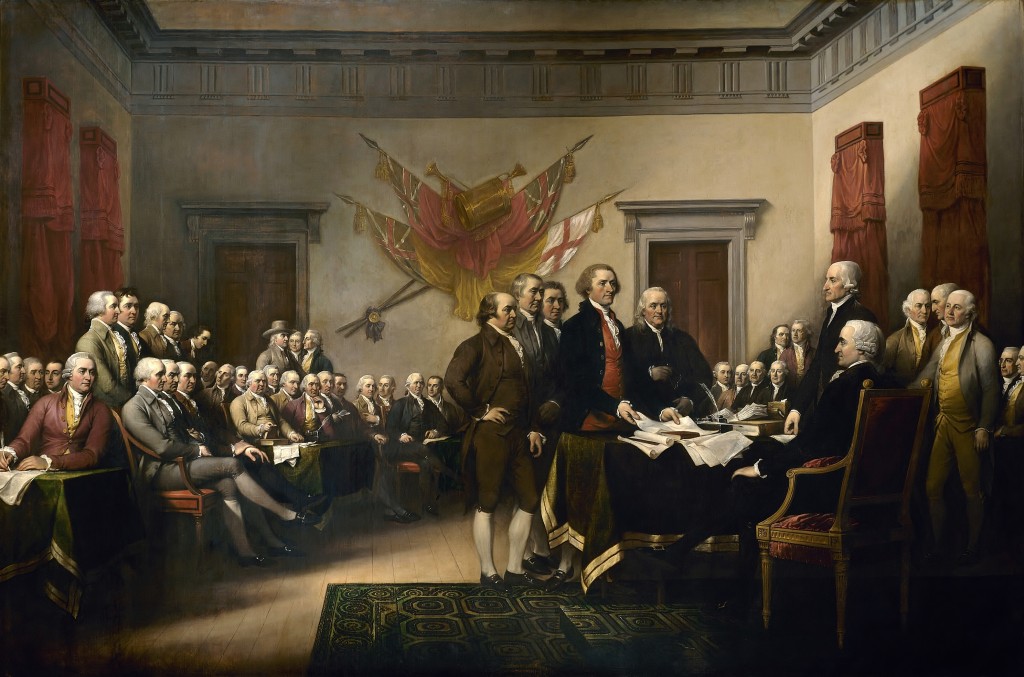
John Trumbull’s Declaration of Independence hangs in the U.S. Capitol Rotunda. It was used as the model for the reverse of the $2 Federal Reserve Note.
May 26, 2015 | books, coins, gold, history, US Mint
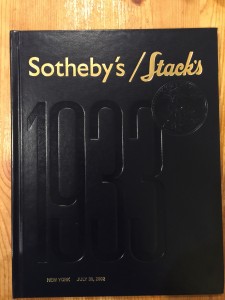 With the court ruling against Joan Langbord and forcing her to surrender the ten 1933 Saint-Gaudens Double Eagle gold coins she claims to have found, there remains only one legally to own 1933 Saint-Gaudens Double Eagle coin.
With the court ruling against Joan Langbord and forcing her to surrender the ten 1933 Saint-Gaudens Double Eagle gold coins she claims to have found, there remains only one legally to own 1933 Saint-Gaudens Double Eagle coin.
Currently, there is only one example of this coin that is legal to own. Dubbed the Farouk-Fenton 1933 Saint-Gaudens Double Eagle, researchers traced the coin was legally exported to Egypt for King Farouk.
In 2002, the coin sold at auction for $7,590,020 to a private collector. As part of the settlement that made the auction necessary, the proceeds were divided between the United States government and British coin dealer Stephen Fenton. The FBI arrested Fenton trying to sell the coin at the Waldorf Astoria Hotel in 1998.
The sale price stood as the most paid for a single coin until the sale of the 1794 silver dollar sold for $10,016,875 in January 2013. While the 1794 silver dollar had a great story, nothing compares to the sale of the coin known as the Farouk-Fenton Double Eagle.
The coin’s colorful history is documented in two books that span the coin’s history from the conditions of their beginning to the auction sale, including being removed from storage at the World Trade Center before its destruction on September 11, 2001.
It is not a coin that an ordinary collector can own. Rather than owning the coin, why not own the auction catalog from that sale?
Stack’s partnered with Sotheby’s to auction the coin. It was the only lot in the auction held at Sotheby’s New Yor headquarters at 6:00 PM on Tuesday, July 30, 2002. The highest bid was $6.6 million when the hammer fell. A 15-percent buyer’s premium made the sale price $7,590,000. To monetize the coin, the government required the $20 face value payment that the Federal Reserve would have paid in 1933.
I purchased the auction catalog from Kolbe & Fanning during a recent sale. It is a special hardbound edition with over 50-pages about the coin, this sale, and its history. Most of the contents were written by David Tripp, who was then the director of Sotheby’s coin, tapestry, and musical instrument departments. Tripp later expanded on what he wrote for the catalog and published Illegal Tender: Gold, Greed, and the Mystery of the Lost 1933 Double Eagle.
It was a beautifully produced auction catalog. Even though the catalog is a summary of Tripp’s book, it is a piece of numismatic history. And since I cannot afford the coins, I bought the book instead of the coin.
Updated on March 12, 2021
Apr 9, 2015 | BEP, currency, history, policy
NOTE: I am doing research into the policies that create our money. This is not a look into the economic policies but what happened after the economic policies are executed. For this series of articles, I wanted to know what happened after it was decided that the country would sell bonds in order to fund the Civil War. This is a summary of some of the research to answer one question and tie it in with history.
First of three parts.
Did you ever want to know how or why something was done but there was no answer? Or there may have been answers but nothing definitive that would make any of the answers true? It is this type of curiosity that had me searching for the answer to one question:
Why is the greenback green?
There are references that claim that the green printed back was to differentiate the currency of the United States from those from other countries. Other references call it an anti-counterfeiting mechanism. Neither claim can tie themselves to the actual events in such a way that we can say which is the truth. Or can we?

Col. Dick Taylor
Shortly after Taylor’s birth, the entire Taylor family moved to Kentucky because of exhausted lands in southern Virginia. They settled along the Ohio River outside of Louisville. In 1814, Giles moved his family Shawneetown, Illinois as one of the area’s pioneer settlers. Unfortunately, Giles died shortly thereafter leaving the family of little means.
Preferring to be called by his middle name, Taylor would be referred to by the common nickname of Dick and began travelling throughout the Midwest region to earn a living. At this time he would sign his name as “E.D. Taylor.” Dick Taylor demonstrated a lot of skill in organizing while operating as a trader on the frontier. By 1929, Taylor settled in Springfield, Illinois and married Margaret Taylor, the daughter of Col. Richard Taylor and sister of then Col. Zachary Taylor.
When the Black Hawk War broke out in 1831, he enlisted in the Illinois infantry and appointed as a colonel by the governor where he served with Jefferson Davis, General George Jones, and General Henry Dodge. Following the war he was elected to the Illinois House of Representatives then, after one term, was elected to the senate defeating a long-standing senator.
Taylor ran his senate campaign on a platform to move the capital from Vandalia to Springfield. To accomplish this, Taylor wrote a bill and worked with a representative named Abraham Lincoln, whom he met as a shopkeeper in New Salem. The bill was successful and Springfield has been the capital of Illinois since.
Taylor was a master at managing money and served the state in many capacities. In 1835, Taylor was appointed Receiver of Public Moneys in Chicago. Today, that position would be known at the comptroller. Under Taylor’s guidance, Chicago managed land sales better than any other city in the country and grew Chicago into the second largest city in the United States passing Philadelphia for that distinction. He was so well regarded in Washington, that not only did President Andrew Jackson hold a special dinner in Taylor’s honor, but appointed him to the commissions that oversaw the building of railroads in the upper Midwest.
With his connections from Springfield and working with Jackson, who is considered the father of the modern Democratic Party, Taylor became a member of the party and helped build the political machine that continues to run Chicago today. He was a friend and staunch supporter of Stephen A. Douglass and would travel the state stumping for Democratic candidates.
Taylor did not forget his friendship with Lincoln. Even though Lincoln had joined the then nascent Republican Party, he would also campaign with his friend in areas that were not strong Democratic strongholds. But for the presidential election of 1860, Taylor supported Douglas and campaigned throughout Illinois against Lincoln.
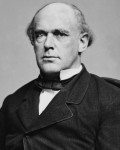
25th Secretary of the Treasury Salmon P. Chase
Knowing how Taylor turned around the finances of Chicago and then the railroad alliance, Lincoln turned to his old friend for advice. Taylor convinced Lincoln to ask congress to issue currency backed by the bonds but with no interest. Using what he learned in managing tickets sales for the railroads, Taylor provided Lincoln the outline for a currency system that was adopted with much reluctance by Chase.
First published in Abraham Lincoln, author Emil Ludwig found a letter acknowledging Taylor as the person who came up with the idea:
My dear Colonel Dick:
I have long determined to make public the origin of the greenback and tell the world that it was Dick Taylor’s creation. You had always been friendly to me. and when troublous times fell on us, and my shoulders, though broad and willing, were weak, and myself surrounded by such circumstances and such people that I knew not whom to trust, then I said in my extremity, ‘I will send for Colonel Taylor — he will know what to do.’ I think it was in January 1862, on or about the 16th, that I did so. Said you: ‘Why, issue treasury notes bearing no interest, printed on the best banking paper. Issue enough to pay off the army expenses and declare it legal tender.’ Chase thought it a hazardous thing, but we finally accomplished it, and gave the people of this Republic the greatest blessing they ever had — their own paper to pay their debts. It is due to you, the father of the present greenback, that the people should know it and I take great pleasure in making it known. How many times have I laughed at you telling me, plainly, that I was too lazy to be anything but a lawyer.
Yours Truly.
A. Lincoln
Lincoln, not one to miss an opportunity, used his executive authority to begin the production of a national paper currency in the form of Demand Notes as an extension of the Act of July 17, 1861 (12 Stat. 259) that authorized the printing of fractional currency.
Since the federal government did not have printing facilities, the law was written to allow notes to be produced by a “New York bank note company.” The first four issues fractional currency were printed by the American Banknote Company and the National Banknote Company. By the fifth issue, the new Bureau of Engraving and Printing began to print these notes.
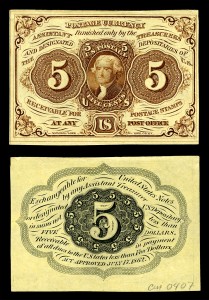
First issue: 5-cents, Thomas Jefferson (Fr. #1231)

Second issue: 10-cents, George Washington (Fr. #1246)
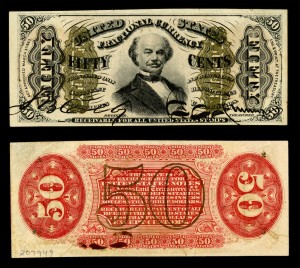
Third issue: 50-cents, Francis Spinner (Fr. #1328)
To save time and money, the first series of notes were printed four and six to a sheet in New York then shipped to Washington where the Treasury set up the Office of the Currency Comptroller to manage. As par of the OCC, the National Currency Bureau was created to do the cutting, bundling, and distribution of the currency.

Fourth issue: 50-cents, Abraham Lincoln (Fr. #1374)
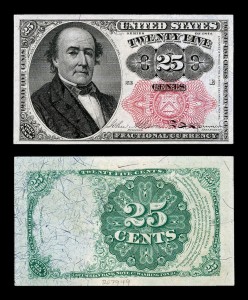
Fifth issue: 25-cents, Robert Walker (Fr. #1308)
The process for the United States to print its own currency had begun. While Secretary Chase was leading the plan to build a printing operation, congress authorized Treasury to establish an engraving and security printing bureau. That law was approved on July 11, 1862 (12 Stat. 532). With construction for a printing facility underway, Treasury hired James Duthie as the first engraver. Although he was a temporary engraver, he was provided a $1,600 per year salary (the equivalent to just under $38,000 in current dollars).
In Part 2 we introduce you to a little known geologist who may have developed more than the theory of the greenhouse effect.
References:
- Conrad, Howard Louis. “The Originator Of Greenback Currency: Colonel Edmund Dick Taylor.” The National Magazine, June 1892, 209-14.
- Ludwig, Emil, Eden and Cedar Paul (translators). Abraham Lincoln. Boston: Little, Brown, 1930.
- Mitchell, Wesley C. A History of the Greenbacks, with Special Reference to the Economic Consequences of Their Issue: 1862-65. Chicago: University of Chicago Press, 1903.
- History of the Bureau of Engraving and Printing, 1862-1962. Washington: Treasury Dept.; 1964.
- Gurney, G., & Gurney, C. (1978). The United States Treasury: A pictorial history. New York: Crown.
- Friedman, Morgan. “The Inflation Calculator.” Accessed April 7, 2015. http://www.westegg.com/inflation/.
Credits:
- Image of Col. E.D. Taylor from The National Magazine, June 1892.
- Image of Salmon P. Chase from the Library of Congress via Wikimedia Commons
- All fractional currency images courtesy of Wikimedia Commons
Mar 12, 2015 | coins, foreign, history
Have you ever started looking for something only to find other items that are more interesting that what you were looking for?
Today’s find in the “To Do” pile is a picture of front of the Saint Petersburg Mint (translated here) taken by my father during his trip to Russia last year. The sign on front facade “моне́тный двор” translates to “Mint.”
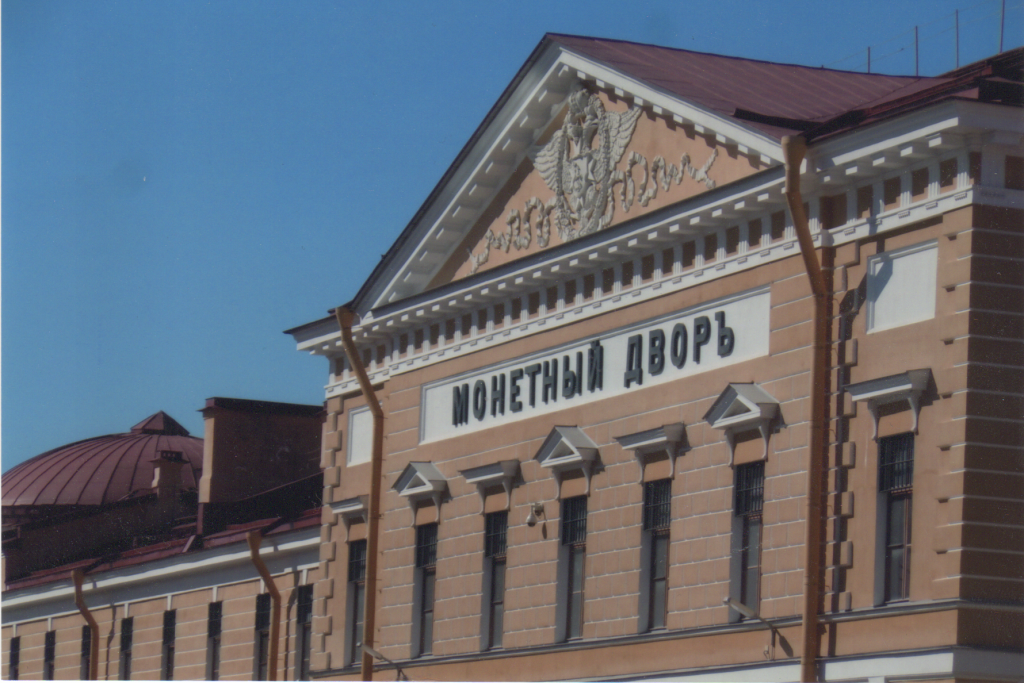
Facade of the Saint Petersburg Mint (2014)
The Saint Petersburg Mint is the oldest mint in Russia. Founded by Peter the Great in 1724, it was the primary producer of coins and currency up until the formation of the Russian Federation and adoption of their current constitution in 1993. The main mint facility is now located in Moscow.
Peter the Great founded Saint Petersburg in 1703 and made it the imperial capital of the Russian empire. Wanting it the to be the most modern city in the world, Peter was proactive in making sure that innovations in infrastructure and cultural life would be available for everyone in the capital. His efforts were fought by the nobility who thought they would lose their power if the government gave more to the people. Peter died in February 1725 from a massive internal infection without realizing many of his dreams for the city.
Following Peter I’s death, Peter’s second wife Catherine I and grandson Peter II, were crowed as tsar of the Russian empire. In 1738, following Catherine’s death in 1737, Peter moved the capital to Moscow but leaving many of the infrastructure behind. Peter II died in 1730 and was succeed by Anna, who was the daughter of Ivan V and niece of Peter I. Anna had been raised with full royal flourishes and chose to move the capital back to Saint Petersburg in 1732 and continue Peter’s westernization efforts for her own pleasure.
The era following Peter I saw the decline of the Russian empire including the degradation of Saint Petersburg as one of the world’s most cosmopolitan city. It wasn’t until the age of Russian Enlightenment under Catherine the Great when there would be improvements in Russian society and the great Mint.
The Russian Enlightenment was the inspiration for Charles Gascoigne to abandon his career as a lead engineer in the steel mills of Edinburg, Scotland and move to Saint Petersburg in 1786. In Saint Petersburg, Gascoigne de a name for himself as an engineer, inventor, and successful businessman. One of his specialties was to take failing businesses and use his engineering skills to modernize their production. One of the businesses Gascoigne turned around was a button foundry whose owner submitted medals made by the machinery to Catherine in order to win a contract to produce more.
Catherine died in 1796 and her son, Paul I was coronated as emperor. Paul was impressed with the details created by the machinery that he was more interested in hiring Gascoigne to update the old minting equipment. Gascoigne first sent engineers to perform the tasks but later took over the projects himself when it was discovered that the machinery being used was in severe disrepair. In 1798 he was assigned the task of determining what it will take to rehabilitate the old Mont.
When Gascoigne did his assessment, he found the entire facility in such disrepair that he proposed a full refurbishing of the facility including buying new machines to coin money. Gascoigne’s plan was to clear everything out of the building and rebuild the floors and walls leaving the outside alone. This included purchasing new equipment and creating new facilities to store and process metals. His plan also included ways to refortify the building that had be subject to thefts. In 1799, Paul issued an imperial degree to allow Gascoigne to execute his plan.
Unfortunately, Gascoigne was caught over charging the Russian bank for materials and was briefly arrested in late 1799. Claiming it was a misunderstanding, a Russian court fined him the amount allegedly overcharged and was allowed to return to the Mint to finish the work.
Gascoigne handed over the management of the mint to the Banking Yard Mint Office Department so that he could concentrate on finishing the reconstruction. Work was finally completed in October 1805 and was handed over the Assignation Bank, who occupied the Mint building. Founded by Catherine the Great, the Assignation Bank was the manager of the money supply in imperial Russia.
The Saint Petersburg Mint survived changes in bank rules in 1843 when the Assignation Bank was dissolved as part of financial reform and the Assignation ruble was recalled and replaced with state credit notes issued by the newly created State Bank. It continued to be the primary producer of coins following the Russian Revolution of 1917 when all of the paper note production was moved out of Saint Petersburg (renamed Leningrad) primarily to Moscow.
Starting in 1961, the Leningrad Mint began to strike commemorative and bullion coins for public sale, primarily to foreign collectors and investors. Although it was the primary mint for creating medals during the existence of the Soviet Union, much of the circulating production was being moved to other facilities within the country. As part of the economic reforms that ended communist rule and formed the Russian Federation, all production of circulating coins were moved to other facilities leaving the Leningrad Mint the country’s producer of medals and collector coins.
As part of the reformation, government offices were consolidated in the capital city of Moscow removing the Mint’s standing as the country’s primary facility. The Leningrad Mint, became a subsidiary facility as part of this reorganization. And with the vote by city residents to rename the city in 1991, it was renamed the Saint Petersburg Mint.
Sep 11, 2014 | history, medals, news, US Mint
Congressional Gold Medal Awarded to the Fallen Heroes of September 11, 2001
WASHINGTON – Three Congressional Gold Medals were awarded today in honor of the men and women who perished as a result of the terrorist attacks on the United States on September 11, 2001. The ceremony took place in Emancipation Hall in the U.S. Capitol Visitor Center.
The United States Mint prepared and struck the three gold medals—one each for the World Trade Center, the Pentagon, and Flight 93 in rural Pennsylvania—in accordance with the authorizing legislation, Public Law 112-76, the Fallen Heroes of 9/11 Act. Each medal bears a unique design.
The New York Medal
The medal’s obverse (heads side) features an abstract representation of two towers. The abstract lines flowing downward symbolize loss while the lines moving upward represent rising above, hope, and deliverance from that loss. This configuration also suggests the World Trade Center’s Twin Towers. The numbers 93, 77, 175, and 11 represent the four planes involved in the tragic events of 9/11 and are positioned as if on a clock, representing the times of the crashes. The words “Always Remember” are set upon a stone wall similar to the wall that bears the names of the victims at the memorial.
The reverse (tails side) features a single rose protruding from an edge at the top, an echo of the memorial in New York where a white rose is placed through the name of each victim on his or her birthday. The inscription reads: WE HONOR THE THOUSANDS OF INNOCENT PEOPLE FROM MORE THAN 90 COUNTRIES LOST AT THE WORLD TRADE CENTER IN THE ATTACKS THAT SHOOK THE WORLD ON SEPTEMBER 11, 2001. MAY THEIR MEMORY INSPIRE AN END TO INTOLERANCE. The design also includes a bald eagle standing sentinel and clasping branches of laurel signifying an eternal honoring of those who perished in the tragedies.
The obverse of the World Trade Center Fallen Heroes’ medal was designed by Artistic Infusion Program artist Joel Iskowitz and executed by United States Mint Sculptor-Engraver Jim Licaretz. The reverse was designed and executed by United States Mint Sculptor-Engraver Phebe Hemphill.

Obverse of the New York Fallen Heroes Medal designed by Joel Iskowitz and engraved by Jim Licaretz

Reverse of the New York Fallen Heroes Medal designed and engraved by Phebe Hemphill
The Pentagon Medal
The medal’s obverse depicts the rebuilt façade of the Pentagon where Flight 77 crashed. The angle of view is the angle of the flight path. A single candle and a small bouquet of flowers and greens signify a sacred memorial at the site. The American flag flies overhead in a united and patriotic embrace.
The reverse features 184 stars on a raised border around the edge of the design, one star for each of the victims of the tragedy. The inscription reads: WE HONOR THOSE ON FLIGHT 77 AND THOSE IN THE PENTAGON WHO PERISHED ON SEPTEMBER 11, 2001. WE WILL NEVER FORGET THEIR SACRIFICE AS WE UNITE IN MEMORY. The design also features a bald eagle standing sentinel and clasping branches of laurel signifying an eternal honoring of those who perished in the tragedies.
The obverse and reverse of the Pentagon medal were designed and executed by Ms. Hemphill.
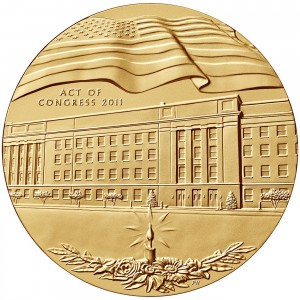
Obverse of the Pentagon Fallen Heroes medal designed and engraved by Phebe Hemphill
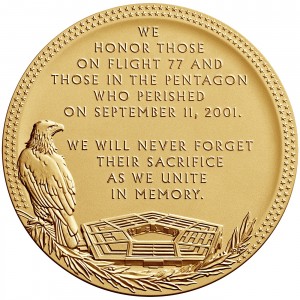
Reverse of the Pentagon Fallen Heroes medal designed and engraved by Phebe Hemphill
The Flight 93 Medal
The medal’s obverse features the hemlock groves behind the boulder at the Flight 93 Memorial, a simple reminder of loss and healing.
The reverse features 40 stars on a raised border around the edge of the design, one star for each victim. The inscription is WE HONOR THE PASSENGERS AND CREW OF FLIGHT 93 WHO PERISHED ON A PENNSYLVANIA FIELD ON SEPTEMBER 11, 2001. THEIR COURAGEOUS ACTION WILL BE REMEMBERED FOREVER. The design also features a bald eagle standing sentinel and clasping branches of laurel signifying an eternal honoring of those who perished in the tragedies.
The obverse of the Flight 93 medal was designed and executed by United States Mint Sculptor- Engraver Joseph Menna, and the reverse was designed and executed by Ms. Hemphill.
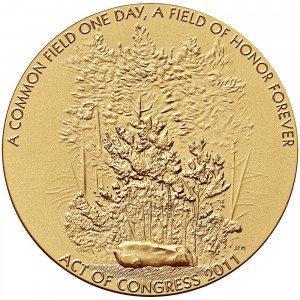
Obverse of the Flight 93 Fallen Heroes medal designed and engraved by Joseph Menna
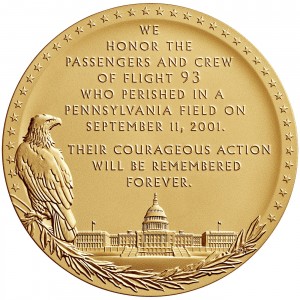
Reverse of the Flight 93 Fallen Heroes medal designed and engraved by Phebe Hemphill
Public Law 112-76, which requires the United States Mint to strike the Fallen Heroes of 9/11 Congressional Gold Medal, also authorizes the bureau to strike and sell bronze reproductions of the medals. The medals will be available for purchase beginning noon Eastern Daylight Time (EDT) Sept. 11, 2014, via the bureau’s online catalog at http://www.usmint.gov/catalog and at 1-800-USA- MINT (872-6468). Hearing and speech-impaired customers with TTY equipment may call 1-888-321-MINT (6468). The three-inch medals—product codes FH1 (New York Medal), FH3 (Flight 93 Medal), FH5 (Pentagon Medal)—will be priced at $39.95.
Images and text courtesy of the U.S. Mint.
Jul 25, 2014 | coins, dollar, history
We choose to go to the Moon in this decade and do the other things, not because they are easy, but because they are hard; because that goal will serve to organize and measure the best of our energies and skills; because that challenge is one that we are willing to accept, one we are unwilling to postpone, and one which we intend to win…. It is for these reasons that I regard the decision last year to shift our efforts in space from low to high gear as among the most important decisions that will be made during my incumbency in the office of the Presidency.
—President John F. Kennedy at Rice University in Houston on September 12, 1962
 On July 20, 1969, just 45 years ago, Neil Armstrong became the first man to walk on the moon fulfilling President Kennedy’s dream. We have learned from those that were there that it was a hard and did require the best of our energies and skills. It was a challenge everyone accepted and made a success in seven years as the social and political turbulence of the 1960s were in high gear.
On July 20, 1969, just 45 years ago, Neil Armstrong became the first man to walk on the moon fulfilling President Kennedy’s dream. We have learned from those that were there that it was a hard and did require the best of our energies and skills. It was a challenge everyone accepted and made a success in seven years as the social and political turbulence of the 1960s were in high gear.
Space continues to be a fascinating topic as the “final frontier” of exploration. While there are areas of Earth’s oceans that remain unexplored, more people look to the stars as the next place for human exploration.
The politics and the politics of space have changed over the years but not the fascination of space exploration. One of the oldest science fiction franchises is based in space (Star Trek) and has been the inspiration for a lot of scientific development. While there were contractors building the parts NASA needed to fly into space, today there are companies that are building their own rockets and planning their own exploration.
Space has been a theme of coins, currency, and stamps around the world. An Internet search using the phrase “space themes on coins” can show a small sample of some of the coins that featured images commemorating space exploration. But the country that landed and walked on the moon first will not be amongst that list.
Although the United States has launched more rockets containing humans into space than any other nation and was the first to walk on the moon, the only tribute to space exploration was the use of the Apollo 11 insignia as the design by Frank Gasparo on the reverse of the Eisenhower and Susan B. Anthony dollars. For the Bicentennial issues in 1975 and 1976, an image of the Liberty Bell was superimposed over part of the image of the moon. This was the idea of Dennis R. Williams who won the design competition in 1974.
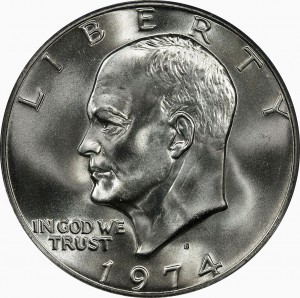
Eisenhower Dollar Obverse
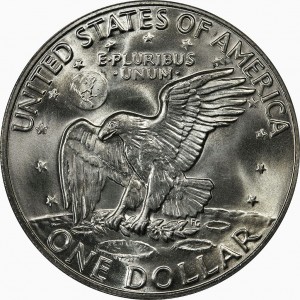
Eisenhower Dollar Reverse

Eisenhower Dollar (Type 2) Bicentennial Reverse
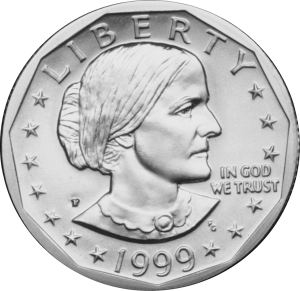
Obverse of the Susan B. Anthony Dollar
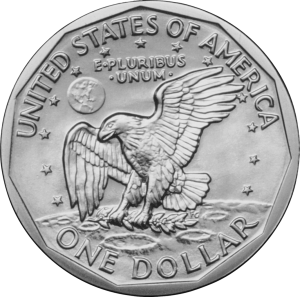
Reverse of the Susan B. Anthony dollar
Given the remembrances of President Kennedy’s assassination and the celebration of the issuance of the half-dollar bearing his likeness, maybe it would be a nice idea to commemorate this achievement with a genuine United States commemorative coin.
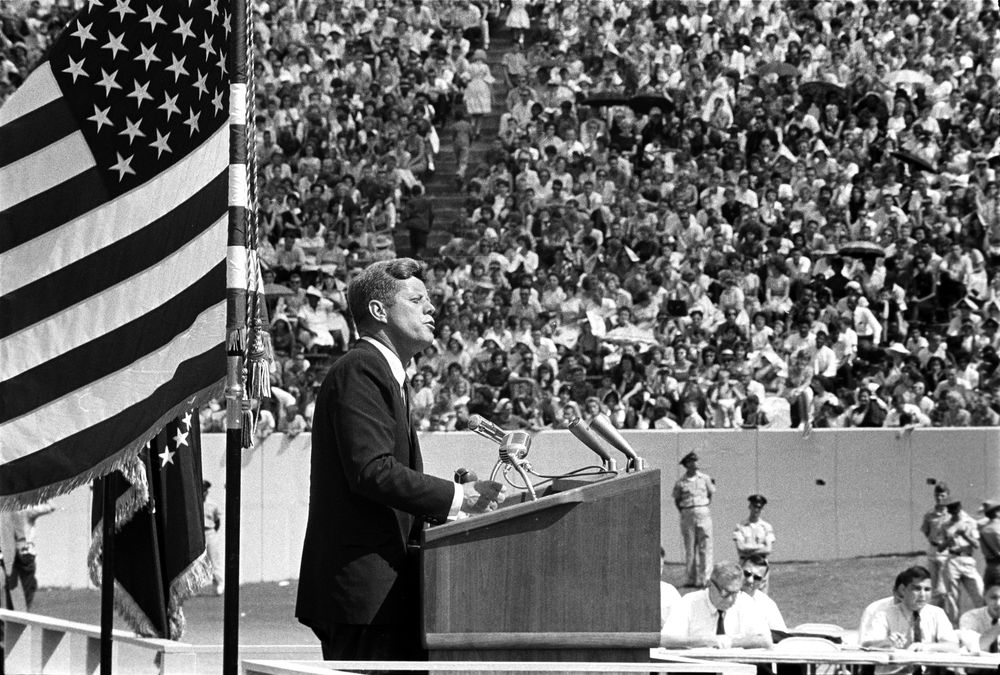
John F. Kennedy speaking at Rice University where he gave his famous speech declaring the U.S. will land on the moon before the end of the decade.
Image of Kennedy speaking at Rice University courtesy of the JFK Library.
All other images courtesy of Wikimedia Commons.
Jul 4, 2014 | coins, currency, history
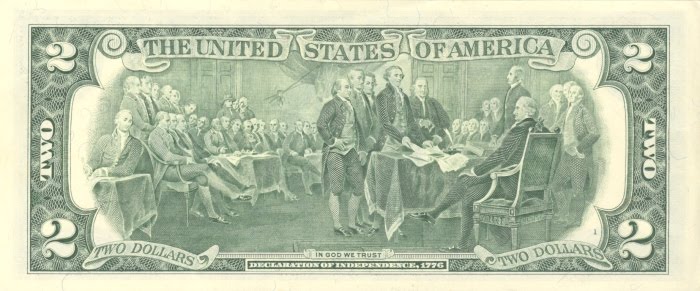
 The Continental Congress met on July 1, 1776 to take up the resolution of Richard Henry Lee, a delegate from Virginia. Lee had brought with him a resolution from the Virginia Convention to “propose to that respectable body to declare the United Colonies free and independent states” that was first heard on June 7, 1776. The July 1 meeting was the culmination of the resolution being documented by John Adams (Massachusetts), Roger Sherman (Connecticut), Benjamin Franklin (Pennsylvania), Robert R. Livingston (New York), and Thomas Jefferson (Virginia). Although the document went through some editing by Franklin and Adams, it was still Jefferson’s words that rang forth:
The Continental Congress met on July 1, 1776 to take up the resolution of Richard Henry Lee, a delegate from Virginia. Lee had brought with him a resolution from the Virginia Convention to “propose to that respectable body to declare the United Colonies free and independent states” that was first heard on June 7, 1776. The July 1 meeting was the culmination of the resolution being documented by John Adams (Massachusetts), Roger Sherman (Connecticut), Benjamin Franklin (Pennsylvania), Robert R. Livingston (New York), and Thomas Jefferson (Virginia). Although the document went through some editing by Franklin and Adams, it was still Jefferson’s words that rang forth:
When in the Course of human events, it becomes necessary for one people to dissolve the political bands which have connected them with another, and to assume among the powers of the earth, the separate and equal station to which the Laws of Nature and of Nature’s God entitle them, a decent respect to the opinions of mankind requires that they should declare the causes which impel them to the separation.
 Asserting their right of freedom from the “the establishment of an absolute Tyranny over these States” was a bold move of this body. One that could land every one of them in jail, ruined, tortured, or dead. But these men, some of great means, risked everything and pursued a path of freedom and justice.
Asserting their right of freedom from the “the establishment of an absolute Tyranny over these States” was a bold move of this body. One that could land every one of them in jail, ruined, tortured, or dead. But these men, some of great means, risked everything and pursued a path of freedom and justice.
We hold these truths to be self-evident, that all men are created equal, that they are endowed by their Creator with certain unalienable Rights, that among these are Life, Liberty and the pursuit of Happiness.—That to secure these rights, Governments are instituted among Men, deriving their just powers from the consent of the governed,—That whenever any Form of Government becomes destructive of these ends, it is the Right of the People to alter or to abolish it, and to institute new Government, laying its foundation on such principles and organizing its powers in such form, as to them shall seem most likely to effect their Safety and Happiness. Prudence, indeed, will dictate that Governments long established should not be changed for light and transient causes; and accordingly all experience hath shewn, that mankind are more disposed to suffer, while evils are sufferable, than to right themselves by abolishing the forms to which they are accustomed. But when a long train of abuses and usurpations, pursuing invariably the same Object evinces a design to reduce them under absolute Despotism, it is their right, it is their duty, to throw off such Government, and to provide new Guards for their future security.
Accusing the King of crimes against the colonies and using his whim, and not laws, to rule the colonies was as immoral as it was illegal. Taxation without representation, the right to govern oneself, housing militia without permission, restricting trade, and suspending trial by jury were some of the accusations levied against the crown.
In every stage of these Oppressions We have Petitioned for Redress in the most humble terms: Our repeated Petitions have been answered only by repeated injury. A Prince whose character is thus marked by every act which may define a Tyrant, is unfit to be the ruler of a free people.
 Even as Benjamin Franklin sought to try to negotiate with the King and his representatives, Franklin toiled with the Continentals as he saw that the King’s court was not negotiating in good faith.
Even as Benjamin Franklin sought to try to negotiate with the King and his representatives, Franklin toiled with the Continentals as he saw that the King’s court was not negotiating in good faith.
Nor have We been wanting in attentions to our Brittish brethren. We have warned them from time to time of attempts by their legislature to extend an unwarrantable jurisdiction over us. We have reminded them of the circumstances of our emigration and settlement here. We have appealed to their native justice and magnanimity, and we have conjured them by the ties of our common kindred to disavow these usurpations, which, would inevitably interrupt our connections and correspondence. They too have been deaf to the voice of justice and of consanguinity. We must, therefore, acquiesce in the necessity, which denounces our Separation, and hold them, as we hold the rest of mankind, Enemies in War, in Peace Friends.
With a final unanimous vote, Richard Henry Lee’s resolution was passed on July 4, 1776. Copies were engrossed over night and formally signed on July 5, 1776 before being dispatched to the colonies.
We, therefore, the Representatives of the united States of America, in General Congress, Assembled, appealing to the Supreme Judge of the world for the rectitude of our intentions, do, in the Name, and by Authority of the good People of these Colonies, solemnly publish and declare, That these United Colonies are, and of Right ought to be Free and Independent States; that they are Absolved from all Allegiance to the British Crown, and that all political connection between them and the State of Great Britain, is and ought to be totally dissolved; and that as Free and Independent States, they have full Power to levy War, conclude Peace, contract Alliances, establish Commerce, and to do all other Acts and Things which Independent States may of right do. And for the support of this Declaration, with a firm reliance on the protection of divine Providence, we mutually pledge to each other our Lives, our Fortunes and our sacred Honor.

On this, the 238 anniversary of the signing of the Declaration of Independence, may you revel in the accomplishment and pray for peace in our time.

John Trumbull’s Declaration of Independence hangs in the U.S. Capitol Rotunda. It was used as the model for the reverse of the $2 Federal Reserve Note.
Image of the Joe Fitzgerald autographed 2005 Jefferson Nickel is property of the author.
John Adams $1 coin image courtesy of the U.S. Mint.
All other images courtesy of Wikimedia Commons.





 The other day I walked into the office of a big-shot producer and pitched a story for a movie that had the possibilities of a sequel. Here is the story I pitched:
The other day I walked into the office of a big-shot producer and pitched a story for a movie that had the possibilities of a sequel. Here is the story I pitched:



